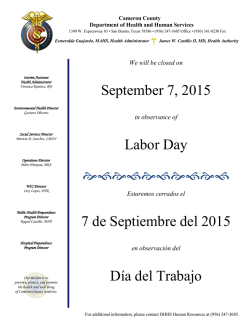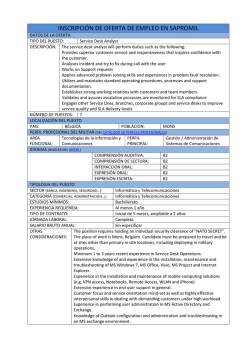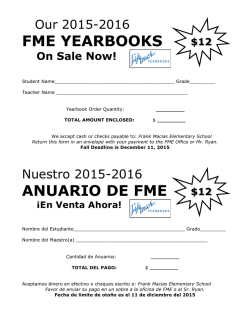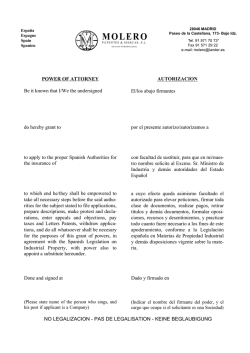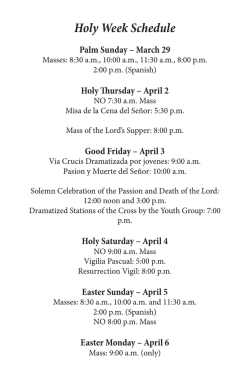
technical information rimac cipermetrina 25 ec
TECHNICAL INFORMATION RIMAC CIPERMETRINA 25 EC FITOSANITARY ACTION: Insecticide ACTIVE INGREDIENT: Cypermethrin FORMULATION AND CONCENTRATION: Emulsifiable concentrate MODE OF ACTION: RIMAC CIPERMETRINA 25 EC is a broad-spectrum pyrethroid insecticide. RIMAC CIPERMETRINA 25 EC is a very active product that acts by contact, ingestion and stomach. PHYTOTOXICITY: RIMAC CIPERMETRINA 25 EC is not phytotoxic at recommended doses and crops. COMPATIBILITY: RIMAC CIPERMETRINA 25 EC may be mixed with most commonly used agrochemicals. It is advisable to perform a compatibility test before the application. TOXICOLOGY: Toxicological category: II Moderately dangerous Oral LD50: Acute Oral: rat: 57 mg/kg (in corn oil). Dermal and ocular LD50: Subcutaneous acute: rat and rabbit: >2.000 mg/kg; minimally irritant for rabbit eyes. Inhalation CL50: rata: >593 mg/m3/ (4h, only through the nose) (maximum concentration reachable). Warning phrase: HARMFUL Toxicological band: yellow HOW TO USE OR APPLICATION APPLICATION EQUIPMENT: Application equipment should be in good working condition, free of leaks and well calibrated. RIMAC CIPERMETRINA 25 EC may be applied using manual, terrestrial or aerial equipment. For terrestrial applications, use a volume of mixture of 400 L/ha or 280 L/mz, and 50 to100 L/ha or 35-70 L/mz for aerial applications (rice – corn). Aerial applications or leaks should be avoided over schools, houses, roads, rivers, brooks, lakes, mangroves or reservoirs. Flights must be performed with: signposted work field, distances should be defined according to application range for the specific aircraft that is going to be used, separation for flight guidance should be marked up to 800 m. When signposts are used, maximum high will be 1 m over the plants level. Use hollow cone nozzles. Use flat fan nozzle tips to apply this mixture. This product does not have any physical nor chemical action on the application equipment. HOW TO PREPARE THE MIXTURE: For mixing use the recommended protective equipment for pesticide handling: boots, respirator, goggles and gloves. Half fill the spray tank, drum, or mixing tank with water. Add the recommended dose of RIMAC CIPERMETRINA 25 EC and mix constantly. Finally, add the rest of water in order to complete application mixture. After finishing application labor is necessary to clean the equipment and provide adequate maintenance. USE RECOMMENDATIONS: USE RECOMMENDATIONS: Belize, Guatemala, El Salvador, Honduras, Nicaragua, Costa Rica, Panamá and Dominican Republic CROP PLAGUES REMARKS Cabbage “Gusano alfiler” Brassica oleracea var. Keiferia lycopersicella Water volume for Capitata “Minador del follaje” terrestrial application Liriomyza sp 56 to 560 liters per “Gusano soldado” hectare Spodoptera exigua Tomato “Gusano del fruto” Water volume for Lycopersicum Heliothis spp. terrestrial application esculentum 56 to 560 liters per hectare Lettuce “Escarabajo” Water volume for Lactuca sativa Leptinotarsa terrestrial application decemlineata 56 to 560 liters per hectare Rice “Gusano cogollero” Oryza Sativa Spodoptera frugiperda “Gusano cortador” Agrotis sp. Spray application “Sogata” volume is 12-30 liters Sogatodes oryzicola per hectare and for “Medidor del arroz” terrestrial application Mocis latipes; Mosis 56 to 560 liters per repanda hectare “Barrenador del tallo” Diatrea sp. “Novia del arroz” Rupela albinella Potato “Falso medidor” Water volume for Solanum tuberosum Trichoplusia ni terrestrial application “Cachón” Papaya Carica papaya Manduca sexta “Lorito verde” Empoasca fabae “Mariposa blanca” Pieris rapae “Polilla del repollo” Plutella xylostella “Chicharrita” Empoasca spp “Mosca blanca” Bemisia tabaci 56 to 560 liters per hectare Minimum volume of 600 L/ha PRECAUTIONS: STORAGE AND TRANSPORTATION: Store and transport in cool, dry, well ventilated areas and containers. Transport separately from feeds, forages and medicines. Keep in hermetically sealed labeled and original container. It is not inflammable, nor explosive, it resists oxidation and light; it’s not corrosive. APPLICATION INTERVAL: Will depend on the critical level of the pest. REENTRY INTERVAL: Preferably reentry 24 hours after application has been made. SIGNS OF INTOXICATION: Head ache, nausea, vomit, local irritation, asphyxia, vertigo, convulsions. FIRST AID: INGESTION: Do not induce vomit since it can cause pulmonary aspiration. Call a doctor immediately. CONTACTWITH SKIN: Remove clothing and wash affected area with soap and water. INHALATION: Move the patient to dry, ventilated place. Loosen clothing and monitor breathing. CONTACT WITH EYES: Flush immediately with plenty of clean water for 15 minutes. Seek medical attention. ANTIDOTE AND MEDICAL TREATMENT: Antidote does not exist. Treat symptomatically. MEASURES FOR ENVIRONMENTAL PROTECTION: toxic to fishes and crustaceans. Do not pollute rivers, lakes and ponds with this product, its containers or empty packages. Toxic to bees. MANAGEMENT OF CONTAINERS, PACKAGING, WASTE AND REMANTS: Use the entire contents of the containers. When empty, wash and rinse the containers three times with clean water and add to already prepared application mixture. Disable empty containers by perforating them. If the country has an official container collection program take the container to the nearest collection center and discard it according to the instructions of the product distributor. In the event of spillage use saw dust or other absorbent material, collect it in a hermetically closed container and deliver it to the distributor. Agroquímica Industrial RIMAC, S.A. Tel: (506) 2573-7751 Fax: (506) 2573-7285 P.O. Box 1863-7050 Cartago, Costa Rica
© Copyright 2025
